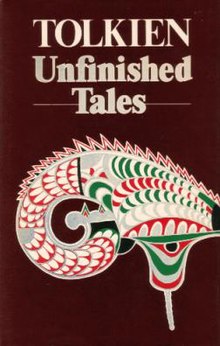Unfinished Tales
 Cover of the first edition. It features Tolkien's drawing of a Númenórean helmet. | |
| Editor | Christopher Tolkien |
|---|---|
| Author | J. R. R. Tolkien |
| Illustrator | Christopher Tolkien (maps) |
| Country | United Kingdom |
| Language | English |
| Subject | Tolkien's legendarium |
| Genre | Fantasy |
| Publisher | George Allen & Unwin |
Publication date | 1980 |
| Media type | Print (Hardcover and Paperback) |
| ISBN | 9780048231796 |
| Preceded by | The Silmarillion |
| Followed by | The Letters of J. R. R. Tolkien |
Unfinished Tales of Númenor and Middle-earth is a collection of stories and essays by J. R. R. Tolkien that were never completed during his lifetime, but were edited by his son Christopher Tolkien and published in 1980. Many of the tales within are retold in The Silmarillion, albeit in modified forms; the work also contains a summary of the events of The Lord of the Rings told from a less personal perspective.
Overview[]
Unlike The Silmarillion, also published posthumously (in 1977), for which the narrative fragments were modified to connect into a consistent and coherent work, the Unfinished Tales are presented as Tolkien left them, with little more than names changed (the author having had a confusing habit of trying out different names for a character while writing a draft). Thus some of these are incomplete stories, while others are collections of information about Middle-earth. Each tale is followed by a long series of notes explaining inconsistencies and obscure points.
As with The Silmarillion, Christopher Tolkien edited and published Unfinished Tales before he had finished his study of the materials in his father's archive. Unfinished Tales provides more detailed information about characters, events and places mentioned only briefly in The Lord of the Rings. Versions of such tales, including the origins of Gandalf and the other Istari (Wizards), the death of Isildur and the loss of the One Ring in the Gladden Fields, and the founding of the kingdom of Rohan, help expand knowledge about Middle-earth.
The commercial success of Unfinished Tales demonstrated that the demand for Tolkien's stories several years after his death was not only still present but growing. Encouraged by the result, Christopher Tolkien embarked upon the more ambitious twelve-volume work entitled The History of Middle-earth which encompasses nearly the entire corpus of his father's writings about Middle-earth.
Contents[]
Part One: The First Age[]
- "Of Tuor and his Coming to Gondolin"
- "Narn i Hîn Húrin (The Tale of the Children of Húrin)"
Part Two: The Second Age[]
- "A Description of the Island of Númenor"
- "Aldarion and Erendis: The Mariner's Wife"
- "The Line of Elros: Kings of Númenor"
- "The History of Galadriel and Celeborn"
Part Three: The Third Age[]
- "The Disaster of the Gladden Fields"
- "Cirion and Eorl and the Friendship of Gondor and Rohan"
- "The Quest of Erebor"
- "The Hunt for the Ring"
- "The Battles of the Fords of Isen"
Part Four[]
- "The Drúedain"
- "The Istari"
- "The Palantíri"
Reception[]
The scholar Paul H. Kocher, reviewing Unfinished Tales in Mythlore, notes that all the stories are linked to either The Silmarillion, Akallabeth or The Lord of the Rings, and extensively annotated, mainly by Christopher Tolkien. In Kocher's view, the stories contain "some of Tolkien's best writing" (and he summarizes them in some detail), though there is much of interest in the editorial material also. He notes the revised map with the additional placenames used in the tales, and that the book does not address Tolkien's poetry.[1]
The Tolkien scholar Corey Olsen notes that Christopher Tolkien chose to present the incomplete tales as they were, adding a commentary to help readers grasp how they fitted in to his father's Middle-earth legendarium. Olson comments that the book's commercial success demonstrated the existence of a market for more of Tolkien's writings, opening up a route to publication of the 12-volume The History of Middle-earth.[2]
Perry Bramlett adds that the book is not for the reader new to Tolkien, nor even one who has read only The Hobbit "or perhaps some or even all of the Lord of the Rings." He notes Christopher Tolkien's warning that the stories "constitute no whole" and that much of the content "will be found unrewarding" to those without a good knowledge of Lord of the Rings. More positively, he cites David Bratman's comment[3] that much of it is as well-crafted as any of Tolkien's writings, and that readers who found The Silmarillion "a little too high and distant" would welcome it.[4]
References[]
- ^ Kocher, Paul H. (1981). "Reviews: Unfinished Tales". Mythlore. 7 (4): 31–33.
- ^ Olsen, Corey (2014). "Unfinished Tales". Mythgard Institute. Signum University. Retrieved 8 August 2020.
- ^ Bratman, David (November 1980). "Unfinished Tales - Review". Mythprint. 17 (6): 1.
- ^ Bramlett, Perry C. (2003). I Am in Fact a Hobbit: An Introduction to the Life and Works of J. R. R. Tolkien. Mercer University Press. pp. 153–159. ISBN 978-0-86554-894-7.
- Unfinished Tales
- 1980 books
- Middle-earth books
- Collections of works by J. R. R. Tolkien
- Unfinished books
- Books published posthumously
- Fantasy short story collections
- Allen & Unwin books